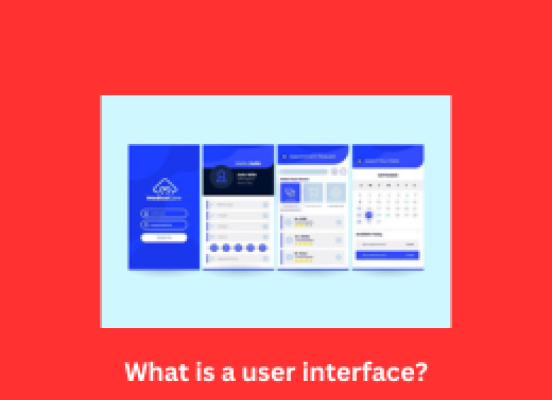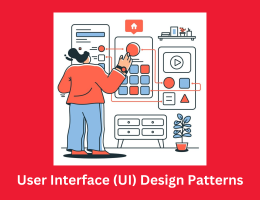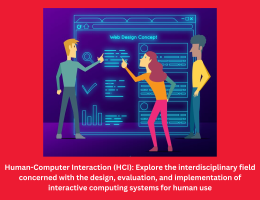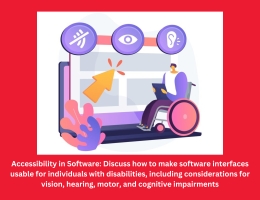
What is a user interface?
- By admin --
- Saturday, 15 Jun, 2024
A user interface (UI) is the point of communique between someone and a machine. It’s what you spot, hear, say, and contact so that you can provide instructions to a tool or get hold of records again from it.
User interfaces dictate how humans interact with devices and software, like cell apps. They’re designed to maximize accessibility, offer a person-friendly revel in, and in the long run assist force conversions.
In the beyond, user interfaces had been primary, and consisted entirely of on-display screen buttons and simple menus that had been controlled thru a keypad, mouse or keyboard. Today, new technologies imply UIs may be tapped, swiped, spoken to, or maybe gestured closer to. Developments like those enable marketers and app builders to create greater reports, seize new facts points in an effort to better apprehend audiences, and analyze interactions, behaviors, and conduct inside apps.
What makes up a person interface?
User interfaces are made from many additives, and that they rely upon the kind of UI (greater on UI kinds underneath), the users, and the stop purpose. While those factors will range, what remains consistent is the requirement to give users the best revel in.
Input additives: Anything you use to initiate an interplay
Menu buttons, checkboxes, dropdown lists, free text fields, radio buttons, and anything you can tap or swipe.
Navigational additives: The factors used to move around an surroundings
A progress bar, breadcrumbs, and seek packing containers.
Graphics and visuals: The additives that shape the basis for the UI
Windows, transitions, menus, icons, text, fonts, snap shots, shade palettes, format, and every other signposting.
Feedback: How the UI communicates again to the consumer
Text containers/messages, coloration adjustments, sound activates, virtual assistants, and haptic remarks.
What are the special styles of consumer interface?
A kind of user interfaces exist to complement the different devices we come upon on a day by day basis.
Ever withdrawn cash from an ATM? Was it a touchscreen? Did it beep while you typed on your PIN? Did the card slot flash whilst it disbursed your cash? That’s an instance of a properly-concept-out UI.
Some UIs, mainly on mobile, can even be adaptable relying on how they’re being used. Music apps like Spotify will transfer to a stripped lower back, muddle-loose, massive-buttoned design while linked to a car stereo to allow less difficult interplay.
Graphical consumer interface
The sort of person interface you’re probably to have the most experience with is a graphical user interface (GUI). GUIs are discovered on displays like smartphones, tablets, laptops, and desktop computer systems. They use icons, menus, window panels, and buttons that will help you control what you want to do. Depending at the tool you’re the usage of, graphical person interfaces usually get hold of input out of your keyboard, mouse, stylus or hands.
Most computer and pc computers are taken into consideration to use graphical person interface components, however a developing quantity of manufacturers now offer touchscreen generation, too. While it could be feasible to have interaction with a computer through touchscreen, it’s on cell gadgets in which this UI in reality plays.
Touch consumer interface
Touch person interfaces (TUIs) are especially designed for interaction with touchscreen devices, however not exclusively smartphones. They need to permit smooth person input even as thinking about display screen size, spacing, legibility, and accessibility. Other places you’ll find touch screen interfaces consist of a few ATMs, in-automobile amusement systems, and transportable GPS devices.
Though the UI to your phone is made from TUI and GUI factors, it genuinely has its very personal UI time period—MUI, or cellular person interface.
Mobile consumer interface
Mobile person interfaces (MUIs) have TUI additives at their center, however construct on them to create a committed UI that higher considers screen length, battery lifestyles and processing energy (think about MUIs as a subcategory of TUIs). Where you’ll find graphical user interfaces on a couple of devices, cell person interfaces are found exclusively on smartphones.
While MUIs should component in accessibility, lightning-brief responses and ever-converting display sizes, they are able to make the maximum of the specific features they get to share residing inside a smartphone, like near discipline conversation, GPS, and biometrics to offer a greater fluid person revel in.
Voice consumer interface
Voice consumer interfaces (VUIs) dispose of the want for physical touch and allow you to interact with a device through speakme. VUIs have become more commonplace in latest years, way to improvements in natural language processing (a computer’s ability to apprehend and respond to a human’s spoken command).
You’ll find voice consumer interfaces within smartphones and clever audio system, each of which deliver digital assistants to reply to queries, like Apple’s Siri, the Google Assistant, and Amazon’s Alexa. Being capable of have interaction with a device with out physical contact or the want to be within view of a display way voice consumer interfaces are very handy. This makes them popular within in-vehicle leisure and navigation structures, as well as in smart homes, where users can speak to their gadgets to cause activities, like controlling thermostats or lighting.
Gesture-primarily based interface
Gesture-based interfaces (GBIs) depend on motion to govern and have interaction with a device. Using motion sensors or cameras, GBIs look for cues from physical actions, like a flicked wrist, nodding head or shifting console controller.
Gesture-based interfaces are popular as they offer an intuitive manner to have interaction with technology, making them famous interfaces inside the world of gaming. Often regarded as a futuristic and advanced manner to manipulate computers and machines, the technology has been inside the mainstream for a number of years, maximum significantly along the creation of the Nintendo Wii in 2006. Almost 20 years later, and with advancements in digital and augmented truth, as well as artificial intelligence, gesture-primarily based interfaces can provide absolutely immersive gaming stories with herbal movements, instead of counting on a conventional keyboard or controller for input.





